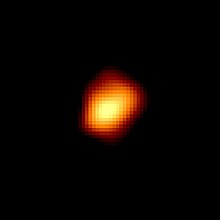Mira
Appearance

Mira is a binary star system with a white dwarf (Mira B, also known as VZ Ceti) star and a red giant (Mira A). Scientists think Mira is 200-400 light years away in the constellation Cetus. Mira A is a variable star, changing its size and brightness. Other red giant stars that do the same are called Mira variables.

Size
[change | change source]Mira has a diameter 332[1] to 541[2] times that of our sun.
If Mira's size was constant, then its diameter would be only 240 times larger than the Sun.[1]
Related pages
[change | change source]References
[change | change source]- ↑ 1.0 1.1 Wood, P. R.; Wittkowski, M.; Weigelt, G.; Scholz, M.; Schöller, M.; Schertl, D.; Richichi, A.; Ohnaka, K.; Hofmann, K.-H.; Driebe, T.; Eberhardt, M.; Woodruff, H. C. (1 July 2004). "Interferometric observations of the Mira star o Ceti with the VLTI/VINCI instrument in the near-infrared". Astronomy & Astrophysics. 421 (2): 703–714. arXiv:astro-ph/0404248. Bibcode:2004A&A...421..703W. doi:10.1051/0004-6361:20035826. S2CID 17009595 – via www.aanda.org.
- ↑ Menten, K. M.; Kemper, F.; Verhoelst, T.; Justtanont, K.; Koter, A. de; Decin, L.; Beck, E. De (1 November 2010). "Probing the mass-loss history of AGB and red supergiant stars from CO rotational line profiles - II. CO line survey of evolved stars: derivation of mass-loss rate formulae". Astronomy & Astrophysics. 523: A18. arXiv:1008.1083. Bibcode:2010A&A...523A..18D. doi:10.1051/0004-6361/200913771. S2CID 16131273 – via www.aanda.org.

